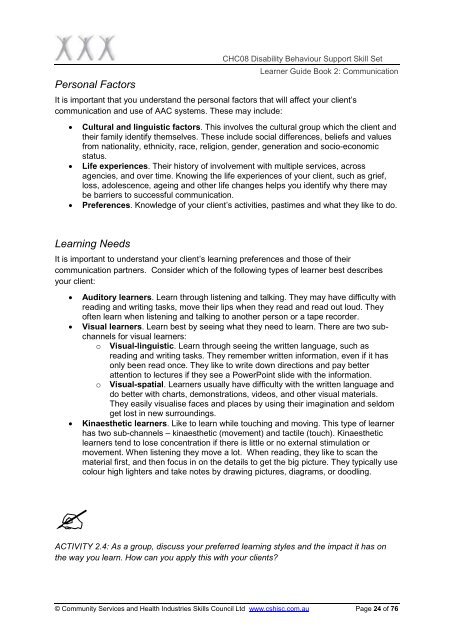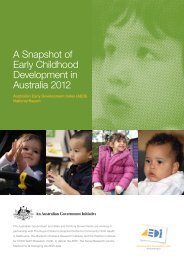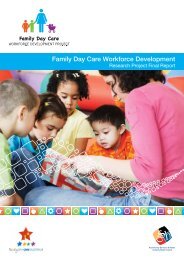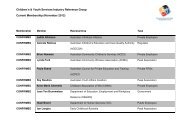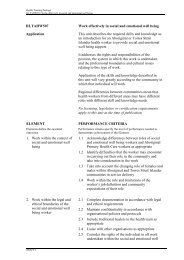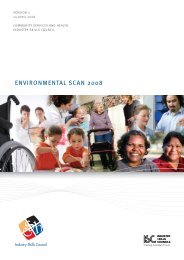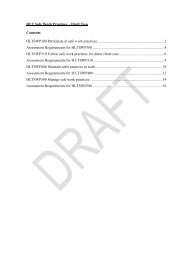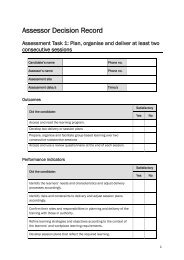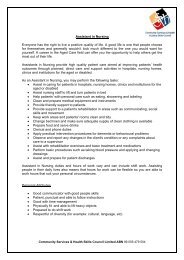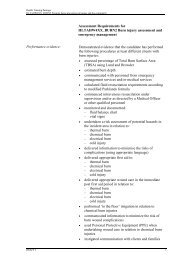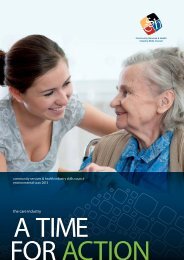CHC08 Disability Behaviour Support Skill Set Learner Resource ...
CHC08 Disability Behaviour Support Skill Set Learner Resource ...
CHC08 Disability Behaviour Support Skill Set Learner Resource ...
Create successful ePaper yourself
Turn your PDF publications into a flip-book with our unique Google optimized e-Paper software.
Personal Factors<strong>CHC08</strong> <strong>Disability</strong> <strong>Behaviour</strong> <strong>Support</strong> <strong>Skill</strong> <strong>Set</strong><strong>Learner</strong> Guide Book 2: CommunicationIt is important that you understand the personal factors that will affect your client’scommunication and use of AAC systems. These may include:Cultural and linguistic factors. This involves the cultural group which the client andtheir family identify themselves. These include social differences, beliefs and valuesfrom nationality, ethnicity, race, religion, gender, generation and socio-economicstatus.Life experiences. Their history of involvement with multiple services, acrossagencies, and over time. Knowing the life experiences of your client, such as grief,loss, adolescence, ageing and other life changes helps you identify why there maybe barriers to successful communication.Preferences. Knowledge of your client’s activities, pastimes and what they like to do.Learning NeedsIt is important to understand your client’s learning preferences and those of theircommunication partners. Consider which of the following types of learner best describesyour client:Auditory learners. Learn through listening and talking. They may have difficulty withreading and writing tasks, move their lips when they read and read out loud. Theyoften learn when listening and talking to another person or a tape recorder.Visual learners. Learn best by seeing what they need to learn. There are two subchannelsfor visual learners:ooVisual-linguistic. Learn through seeing the written language, such asreading and writing tasks. They remember written information, even if it hasonly been read once. They like to write down directions and pay betterattention to lectures if they see a PowerPoint slide with the information.Visual-spatial. <strong>Learner</strong>s usually have difficulty with the written language anddo better with charts, demonstrations, videos, and other visual materials.They easily visualise faces and places by using their imagination and seldomget lost in new surroundings.Kinaesthetic learners. Like to learn while touching and moving. This type of learnerhas two sub-channels – kinaesthetic (movement) and tactile (touch). Kinaestheticlearners tend to lose concentration if there is little or no external stimulation ormovement. When listening they move a lot. When reading, they like to scan thematerial first, and then focus in on the details to get the big picture. They typically usecolour high lighters and take notes by drawing pictures, diagrams, or doodling.ACTIVITY 2.4: As a group, discuss your preferred learning styles and the impact it has onthe way you learn. How can you apply this with your clients?© Community Services and Health Industries <strong>Skill</strong>s Council Ltd www.cshisc.com.au Page 24 of 76


